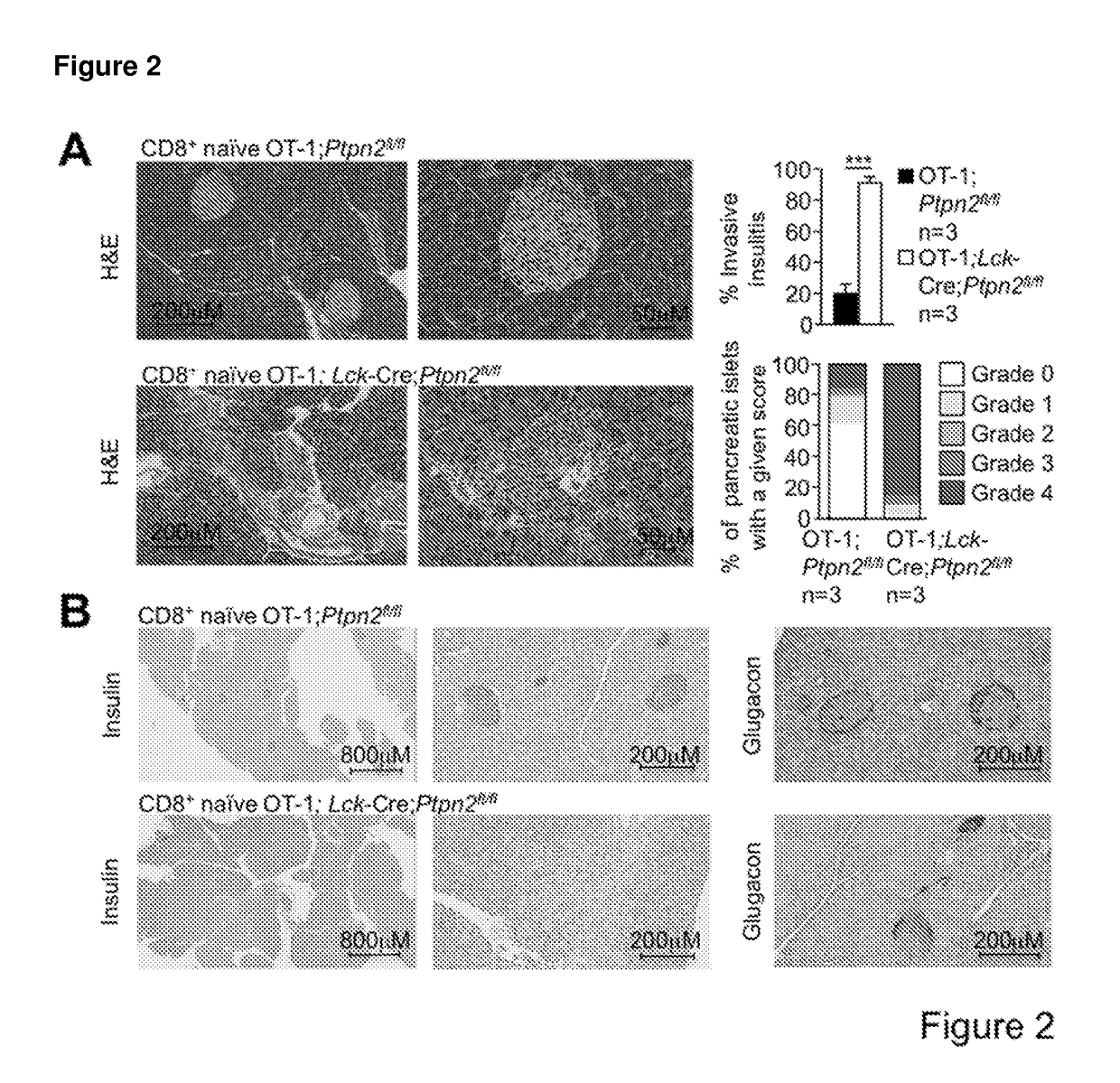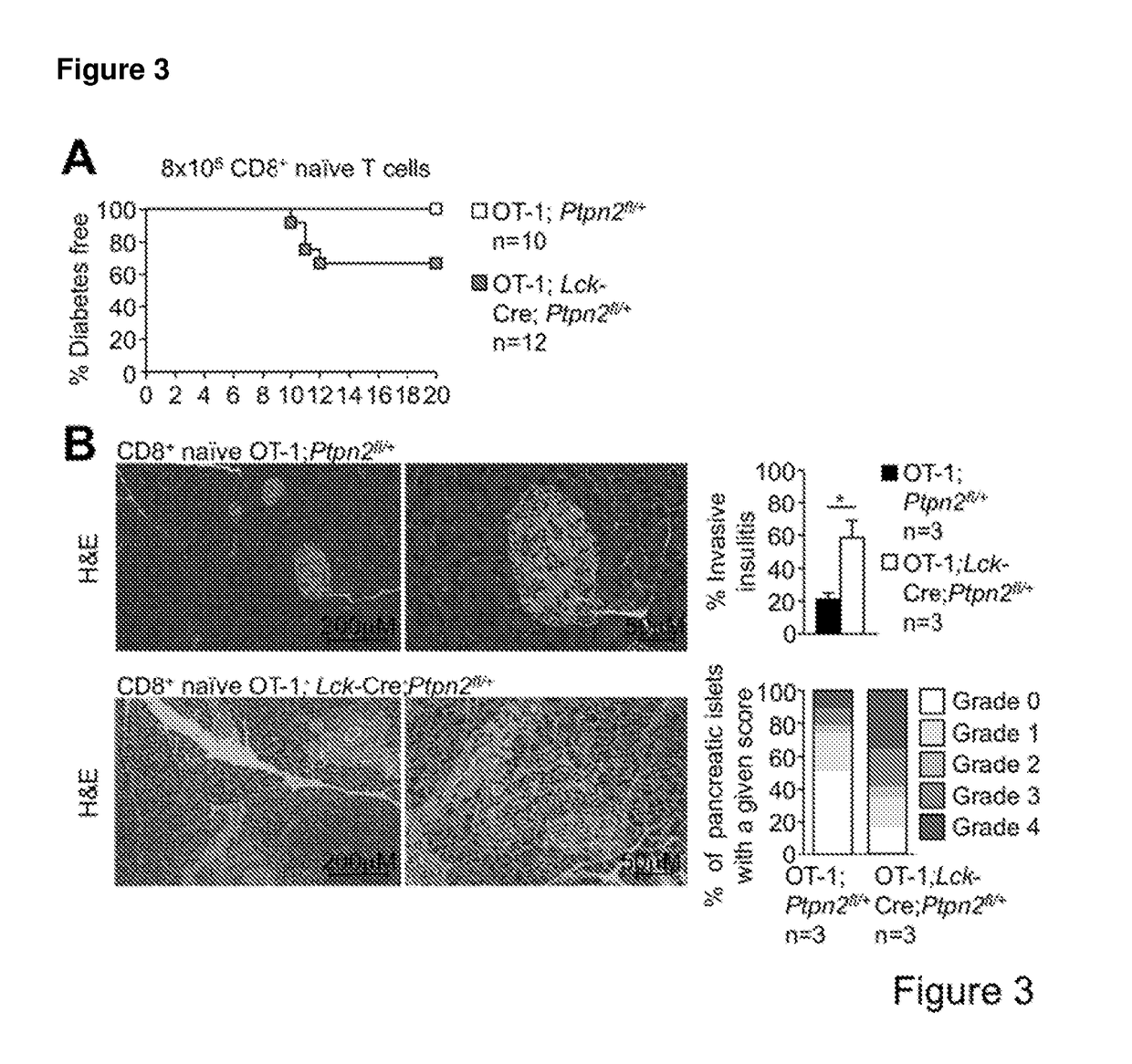Method of producing leukocytes using ptpn2 inhibition for adoptive cell transfer
a technology of ptpn2 inhibition and leukocytes, which is applied in the field of preparing cells ex vivo for use in immunotherapy, can solve the problems of limited methods currently used to prepare cells for use in adoptive cell therapy, and achieve the effects of promoting differentiation of t cells, reducing ptpn2 activity, and enhancing immune respons
- Summary
- Abstract
- Description
- Claims
- Application Information
AI Technical Summary
Benefits of technology
Problems solved by technology
Method used
Image
Examples
example 1
[0165]Mice
[0166]Ptpn2fl / fl (C57BL6), Lck-Cre; Ptpn2fl / fl (C57BL6) and RIP-mOVA (C57BL6) were maintained on a 12 h light-dark cycle in a temperature-controlled high barrier facility with free access to food and water. 6-10 week old female recipient mice and 3-6 week old male or female donor mice were used for adoptive transfers. For ex-vivo experiments either male or female mice were used; Ptpn2fl / fl and Lck-Cre; Ptpn2fl / fl or corresponding OT-1 mice were sex-matched. Ptpn2fl / fl and Lck-Cre; Ptpn2fl / fl mice and the corresponding OT-I TCR transgenic mice were described previously (Weide F W (2013) Nature Commun In press.). RIP-mOVA transgenic mice (Kurts C, et al. (1996) Constitutive class I-restricted exogenous presentation of self antigens in vivo. The Journal of Experimental Medicine 184(3):923-930.) were a gift from Bill Heath (University of Melbourne, Australia).
[0167]Materials
[0168]Recombinant mouse IL-2 was purchased from PeproTech. SIINFEKL peptide was purchased from JPT Pepti...
example 2
[0191]PTPN2-Deficient OT-1 CD8+ T Cells Promote Type 1 Diabetes in RIP-mOVA Mice in the Absence of CD4+ Help.
[0192]To examine the consequence of PTPN2-deficiency on CD8+ T cell cross-priming and the development of autoimmune diabetes we took advantage of RIPmOVA mice (Kurts C, et al. (1996) The Journal of Experimental Medicine 184(3):923-930.). RIP-mOVA mice express a membrane bound form of ovalbumin (OVA) in the β cells of the pancreas and in the renal proximal tubular cells of the kidney (Kurts C, et al. (1996) The Journal of Experimental Medicine 184(3):923-930.). However, thymic expression of OVA as ‘self’ in RIP-mOVA mice results in tolerance. OT-1 mice express the Vα2 / Vβ5 TCR that is specific for the OVA peptide 257SIINFEKL264 (presented in the context of Kb class I MHC) selecting for CD8+ single positive thymocytes (Hogquist K A, et al. (1994) Cell 76(1):17-27.). The adoptive transfer of naive OT-I CD8+ T cells alone into RIP-mOVA mice results in cross-presentation and the de...
example 3
[0206]The following is an exemplary method of producing CAR-T cells using retroviral infection (Cheadle E J et al. J Immunol 2010; 184:1885-1896). This approach to expressing a specific CAR is also relevant for expressing a shRNA or siRNA to reduce the expression of PTPN2 in CAR-T cells or any other T cell type described herein. While this method is designed for application in a murine setting, changes can be made for application in humans based on methodology described in, for example, Themeli, et al. (2013), Nature Biotechnology, 31(1), pp 928 to 933 (including associated online methods) and Tran et al. (2014), Science, 344, pp 641 to 645.
Day 0—Isolation of T-Cells
[0207]1. To isolate splenocytes, excise spleen from BI / 6 mouse[0208]2. Spray EtOH on mouse and utensils (scissors / forceps).[0209]3. Make incision on back of mouse and use fingers to pull back skin.
Spleen is on left side, bright burgundy colour.[0210]4. Snip of fat attaching it to abdomen and place in petri dish (non-coat...
PUM
| Property | Measurement | Unit |
|---|---|---|
| Fraction | aaaaa | aaaaa |
| Level | aaaaa | aaaaa |
Abstract
Description
Claims
Application Information
 Login to View More
Login to View More - R&D
- Intellectual Property
- Life Sciences
- Materials
- Tech Scout
- Unparalleled Data Quality
- Higher Quality Content
- 60% Fewer Hallucinations
Browse by: Latest US Patents, China's latest patents, Technical Efficacy Thesaurus, Application Domain, Technology Topic, Popular Technical Reports.
© 2025 PatSnap. All rights reserved.Legal|Privacy policy|Modern Slavery Act Transparency Statement|Sitemap|About US| Contact US: help@patsnap.com



